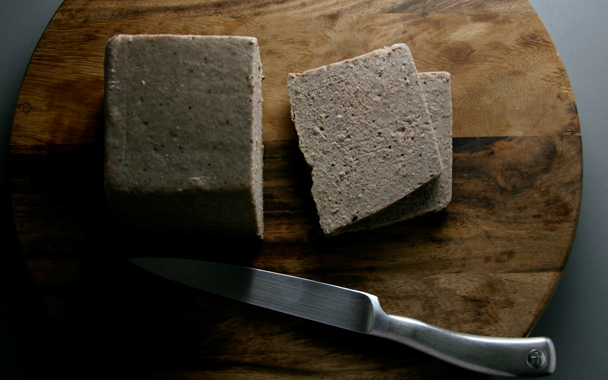Like the early 2000s, the 1700s were a time of great change in this country. Hoards of immigrants poured into the United States, bringing with them their customs, languages, and cuisines. Not so different than today, really—except that in the 1700s, the immigrants were mostly German. Many of them would never even learn to speak English. My ancestors were no exception. Just off a narrow, windy rural route in Pennsylvania there is a small graveyard; the headstone marking the plot of one Johann Christopher Knauer, died 1769, is etched entirely in German. He and his family integrated their food and customs to their new land. And there’s a good chance that most mornings for breakfast, Johann ate scrapple.
If you know what scrapple is, you already either love it or hate it; scrapple brooks no indifference. If you don’t know what scrapple is, let this serve as a brief introduction.
The original purpose of scrapple was to use up cuts of meat that were left over from the animal (a pig, usually) after it was butchered. This often included any meaty bones, edible organs, and entrails. You know, the scraps. They were boiled with a little water until everything fell apart, then buckwheat and cornmeal were added to thicken the mixture before it was cooled in pans. Just before serving, the gelatinized mass was sliced thin and seared, resulting in an ultra-crispy outside and a melting interior. If you didn’t grow up eating it, it’s hard to get past the idea of organs and entrails for breakfast. If you did grow up eating it, it’s just about the best thing in the world.
I bought some last week from a Pennsylvania Dutch butcher shop called Baringer’s, and as the woman behind the counter wrapped my breakfast-to-be in paper, I cautiously asked her for the recipe. To my great surprise she eagerly rattled it off. About 200 pounds of meaty pork bones, about 75 pounds of meaty beef bones, some cheeks from each kind of animal, and so on, right down to buckwheat flour. Then she finished with a cheerful, “And you know it’s good!”
And it is.
She was happy to share her recipe because, after hundreds of years of local scrapple cooking, there are no more secrets, only variations. It’s just butcher scraps, buckwheat, and cornmeal. It is the product of the thrift and ingenuity of immigrants—the very ingredients that continue to make this country (and its food) so wonderful.




 Pinterest
Pinterest


